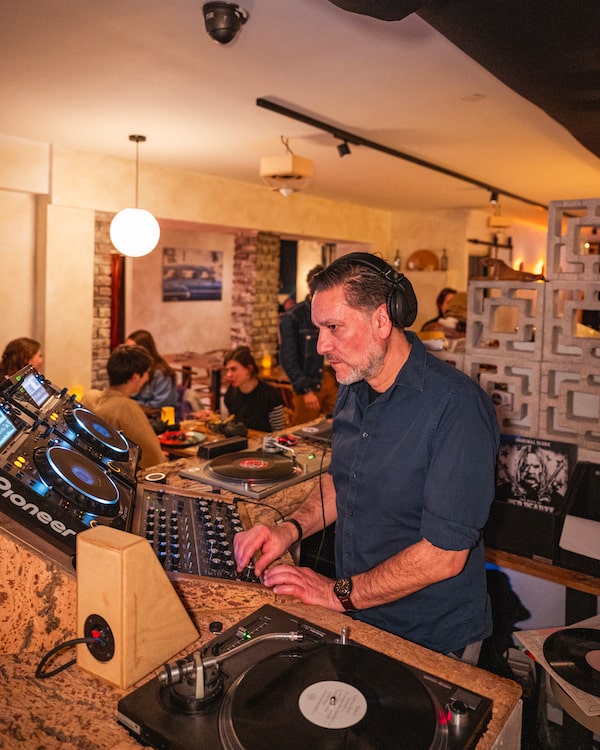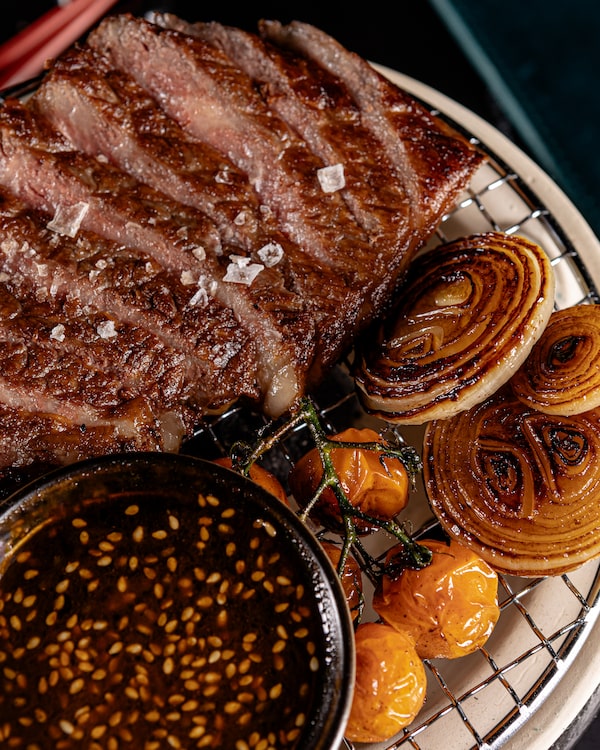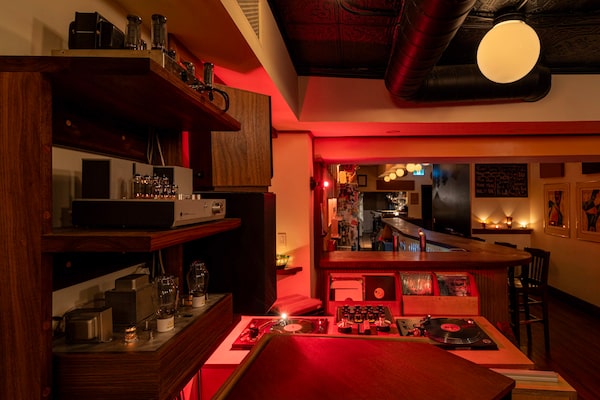At Bambino in Paris’s trendy 11th arrondissement, chef Kenta Tomoda sends out tiny tartelettes of foraged mushrooms, mounds of paccheri sprinkled with chestnut, pecan and gorgonzola, and gossamer-thin cecina ham doused in yuzu and capers. A mustachioed server swings by to refill €10 ($15) glasses of Domaine de la Tournelle Cul de Brey, a biodynamic blend that pairs well with cheese and charcuterie.
A few steps away, the party has already started. In a space no larger than your average kitchen, two massive retro wood speakers are pumping out rare grooves and neglected 1970s funk as the DJ feverishly flips through stacks of LPs. Diners have started to push aside their chairs with the rock of a hip. The velvet curtains at the door suck in new guests, even though wiggle room is scarce.
It’s hard to know whether the oral or aural delights are more accountable for the general euphoria. Both seem to benefit from equal investment in attention and creativity. Both are being devoured in equal measure – though the musical segues elicit louder cries of praise. To use retail parlance, Bambino is a one-stop evening shop, combining high bistro standards with the easy-going spirit of the pub and the energy of a nightclub – a dressed-down Studio 54.

H/eart.h in Amsterdam uses its Japanese-made acoustic booth to pull focus the way an open kitchen would.Handout
Such is the philosophy of the “listening bar” – or hi-fi or vinyl bar, as it’s varyingly called. Listening bars take the menus of daring young chefs and offer the decade’s hottest pairing – not only natural vintage wines but also vintage sounds, played the way the artists intended. If you’re the going-out type, you’ve probably been to one, even if you didn’t know it.
Listening bars don’t hide their reverence for the long-established Japanese concept kissa, launched in dimly lit Tokyo salons between the wars. The only places to hear American jazz, taste imported whiskey and savour local snacks, kissa bars only barely survived the Second World War. Their rise and decline shadowed the 20th-century supper club, losing steam as their offerings became less rarified and easier to consume at home. But if you look at old photos, with their boxy teak sound systems and walls of records, they bear a striking resemblance to Bambino.
And not just Bambino. Few cities are immune to the allure of hi-fi-and-dine. At H/eart.h in Amsterdam, a Japanese-designed acoustic booth pulls focus the way an open kitchen might once have ruled. Weekend listening sessions at the “audio bar” take place during the dinner service, a set vegan menu featuring beet “rawvioli” and cashew cheese. The food is surprisingly memorable – easy to eat with punches of umami flavour – though the playlist is arguably more so. A half-hour uptown, a hi-fi microbrewery called Oedipus streams electronic DJ sets on the house-run satellite radio station while diners feast on Asian tapas and flights of home-brewed beer.
At Brooklyn's Eavesdrop, you can revel in vintage hip-hop, jazz and eight-hour-braised brisket with miso carrots.Handout
In Brooklyn there’s Eavesdrop, where you can revel in vintage hip-hop, jazz and eight-hour-braised brisket with miso carrots. The name alludes to the decibel level – the sound system may have the potential to deafen you, but it’s adjusted so you can overhear your neighbours’ conversation. London’s latest is Bambi (no relation to Bambino), booked up through the week with gangs of friends who push aside the tables after their octopus with nduja and boogie to Fela Kuti. Vancouver has Kissa Tanto, a Japanese-Italian concept in an intimate Chinatown lounge geared toward small groups, to keep voices down.
Last summer, Toronto entrepreneur Dan Gunam opened Kissa with a vinyl-only listening lounge that takes pride in playing nothing after 2015. Gunam is equally committed to his menu of Japanese snacks, such as tempura rock shrimp and the decadent wagyu katsu sandwich.
“We know people have a predetermined notion that just because a place has music, DJs and partying, the food is bad,” he says. “We wanted to change that. Our purpose is to bring our guests an experience that can transport them to somewhere else. Either they get to remember an old memory when they hear a particular song, or they feel like they’re in New York City or Paris. And when they try our dishes, we can take them on a journey.”
Gunam emphasizes the dialogue between the music, food and cocktails, such as the Soul Album, a brandy-espresso-rice milk concoction inspired by 1960s soul.

'We know people have a predetermined notion that just because a place has music, DJs and partying, the food is bad,' says Dan Gunam, who opened the vinyl-only listening lounge Kissa. 'We wanted to change that.'Handout
It doesn’t take a scientist to appreciate the winning combination of a crisp, mellifluent soundtrack and a dish that hits all the right notes. “Music transports people. It evokes other eras, other places,” Bambi owner James Dye says, accounting for the gushing reviews. “It’s disarming, in a good way.”
Still, the scientists have had a go anyway. In a 2014 University of Arkansas study, researchers found that music genres such as jazz contributed to the enjoyment of certain foods, and a 2023 article in the International Journal of Gastronomy and Food Science found certain background music to enhance the perception of salty flavours, specifically. The “salty” soundtrack was composed of staccato notes with a medium pitch.
Experiments conducted in Parisian bars in 2004 observed that patrons drank more when music levels were turned up a notch. And though some of us have reached the age where we actively avoid situations with a booming soundtrack, our taste buds might benefit, according to a 2015 Cornell University study that found louder environments augmented umami flavours, such as the ka-pow you get from MSG. Investigators attributed this to stimulation of the chorda tympani nerve, which transmits taste fibres between the front part of tongue and the auditory tube.

The Little Jerry in Toronto prioritizes leisurely consumption and conversation over all-out clubbing.Jonathan Adediji/Handout
There’s a delicate balance to this special chemistry that not everyone can pull off. Like Eavesdrop, the Little Jerry in Toronto prioritizes leisurely consumption and conversation over all-out clubbing, lest anyone be put off their dinner. Owners Jodie Dewald and Saad Qattan invested in a quality high-fidelity system that could play at a powerful volume while still enabling quiet chat. The music doesn’t overtake the concept, even if the telltale wood speakers inform the decor. Like many listening bars, says Dewald, “there’s a seventies, grandma’s basement aesthetic, which I love, and it’s built around those big wood-grain boxes that dominate the room.”
This is what makes Jerry work, along with a real passion for the details. Dewald has waited tables, worked in the wine industry and, as a DJ, collected hundreds of records in a huge diversity of genres she likes to showcase regularly. Her wine-by-the-glass menu is nearly as vast. And most of her hires were loyal customers first. The small kitchen can fit only two staff at a time yet delivers hefty dishes such as wild-caught Japanese hamachi crudo with hibiscus, and a two-week marinated duck breast, served with squash mole and charred Ontario corn.
“You can feel it when you go into places, if they have a soul or not,” she says. “It’ll be cobbled together from things they’ve seen, things they know and are experienced in.”
By its nature, the recipe is hard to replicate and resistant to expansion. And that may end up being its secret weapon.
One in a regular series of stories. To read more, visit our Inspired Dining section.